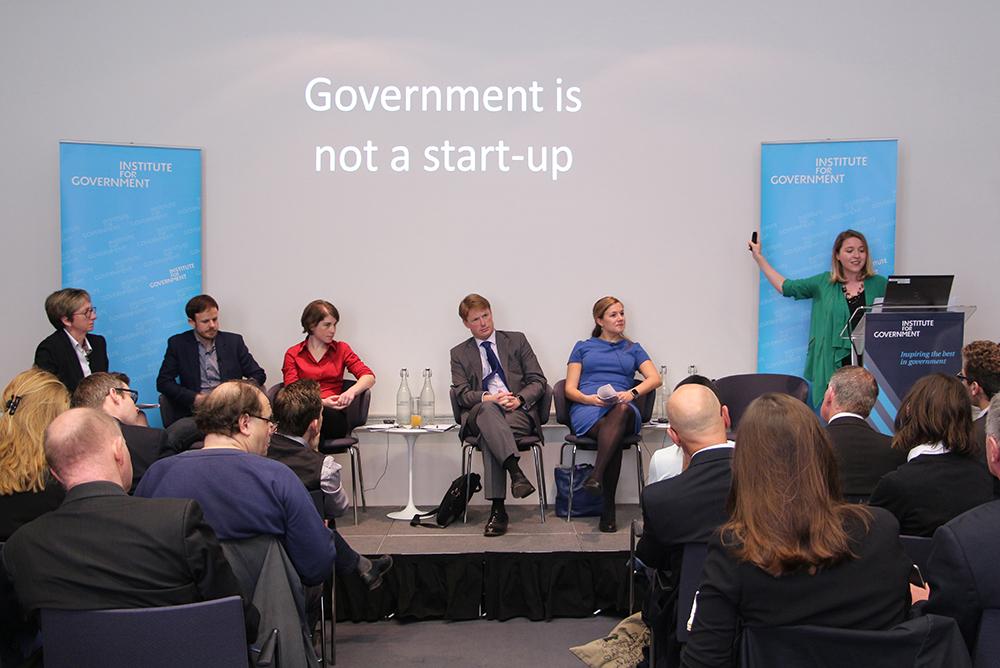Making a success of digital government
The success of digital reform in this Parliament will rely on a new kind of leadership – involving the whole of government
This week we launched our report, Making a success of digital government, at an event with experts from inside and outside government. Emily Andrews says the event highlights that the success of digital reform in this Parliament will rely on a new kind of leadership – involving the whole of government.
The Passport Office was one of the first parts of government to enter the internet age. As early as 2002, you could fill out your passport renewals form online. But then you had to wait for the Passport Office to print it out and send it back to you, for you to sign it… and then post it back. No longer.
On the new passport renewals service, people can upload a photo from their phone, and tick a box to declare the legitimacy of their information: no printing or signing required. That is what digital government is really all about: it’s not about putting forms on websites, it’s about making interactions between government, citizens and business as seamless and efficient as possible. But digital teams can’t do it alone.
A task for the whole of government
Technological change, and people who understand it, allowed the new passport renewals service to benefit from photo-recognition software. But equally as important was the work of policy, operational and legal colleagues, removing the need for a physically signed ‘wet’ signature. This is the point I tried to emphasis at the launch of our report: that making a success of digital government will require work from the whole of government, not just digital and technology leaders.
As Kit Collingwood-Richardson, Deputy Director for Universal Credit, says: ‘We need leaders who recognise what good looks like for government transformation.’ Leaders who understand both the Whitehall machine, and digital ways of working. Too often, the people at the top of departments have no experience delivering them, and they’re liable to get it wrong. Collingwood-Richardson points out that the Civil Service is growing a cohort of digitally-experienced future leaders, with new career paths being developed to help them get to the top.
In the meantime, our report says that the drive for digital transformation should come right from the top – and we haven’t heard from the Prime Minister on this yet, unfortunately.
Clarifying the role of the centre
The centre of government – in this case, the Government Digital Service (GDS) – has been crucial in getting digital approaches in government to the point they are now. The passports renewals service was part of their exemplar programme. But in the continued absence of a digital strategy, everyone now wants to know what’s next. So it’s good news that GDS’s new Chief Executive Kevin Cunnington has confirmed that the long-delayed Government Digital Strategy will be ready by Christmas.
Alex Holmes, Chief Operating Officer of GDS, hinted at what would be in it. GDS will continue to be a ‘strong centre’, he says, at this time of national challenge, supporting departments through a coaching relationship, but also ensuring they ‘do they right thing’ using the spending controls. However, Charlotte Jee, Editor of Techworld, remains concerned that the more ‘friendly, benign’ tone of GDS might also signal complacency. Holmes argues that a strong GDS was necessary to make sure departments worked together across organisational boundaries. But, as Collingwood-Richardson put it, ‘money talks’.
The way departments are funded can block or enabled collaborative working, so HM Treasury must also be a key part of this equation. Oliver Morley, Chief Executive of the Driver & Vehicle Licensing Agency (DVLA), is calling for the new digital strategy to focus on putting citizens first, suggesting that GDS is as liable as anyone else in government to become distant from the end-users of digital services.
Our research shows that different parts of government, within and across departments, often think they have the best understanding of ‘the user’. Making a reality of this principle will involve further exploration of what it actually means. We’ve reached a tipping point. The digital reform agenda has a lot still to offer – but its continued success is far from assured.
The experts on our panel unanimously agree that we now need a fundamental change in the government’s approach. And everyone in government must work to make it a success.
Read the report – Making a success of digital government
Watch the launch event
- Topic
- Public services
- Keywords
- Data and digital Technology
- Administration
- May government
- Department
- Home Office Department for Work and Pensions
- Publisher
- Institute for Government
